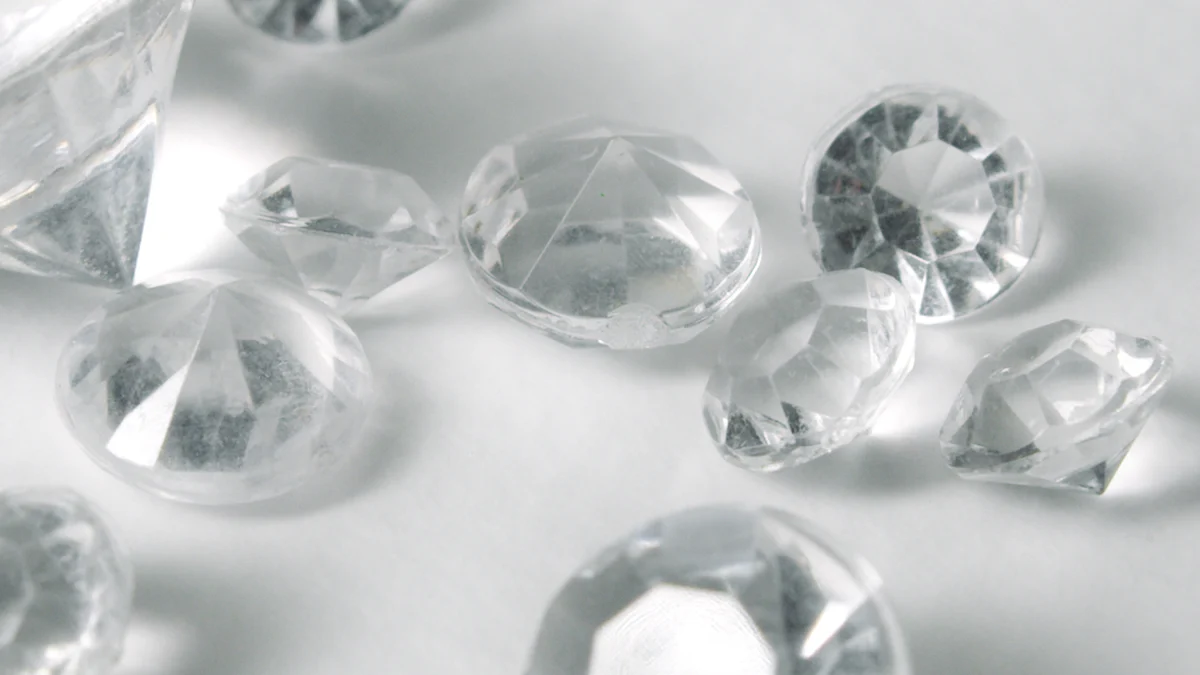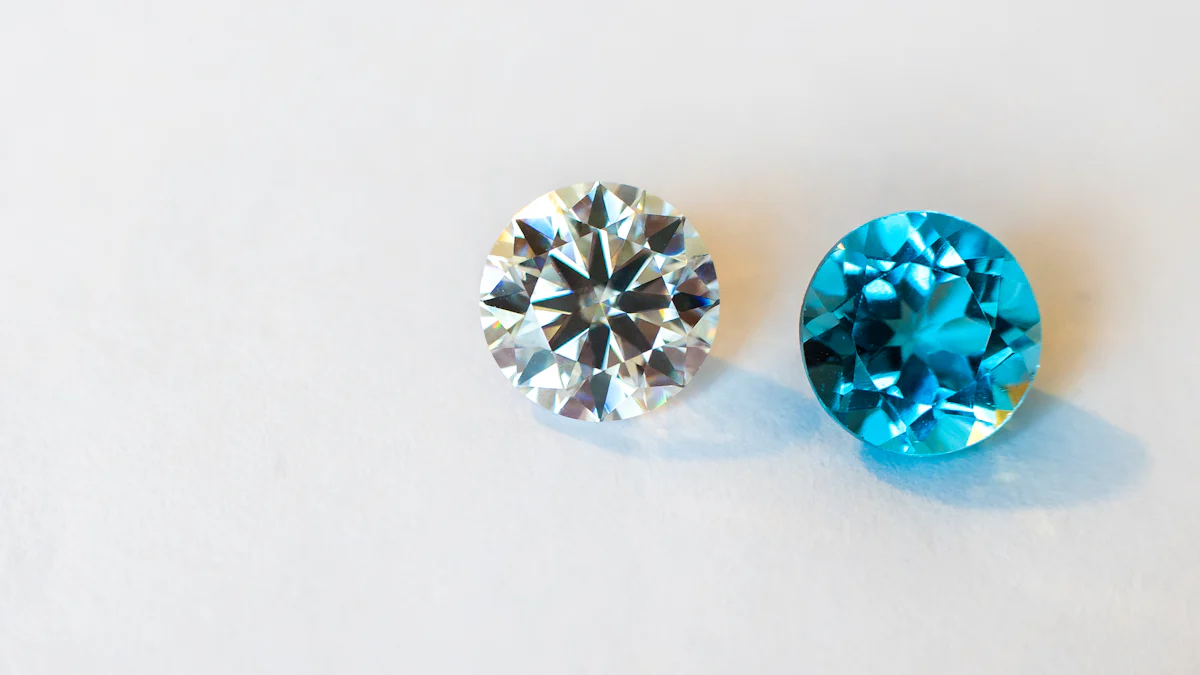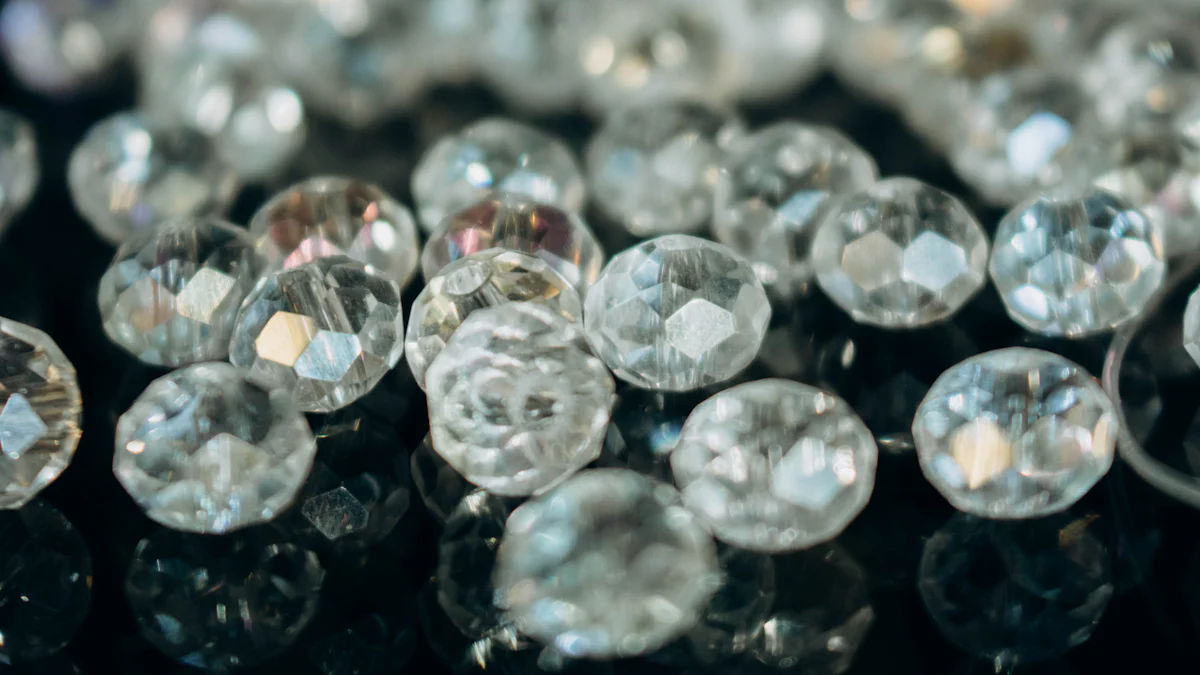Tips for Choosing High-Quality SI Diamonds

SI diamonds, or "Slightly Included" diamonds, sit in the middle of the diamond clarity scale. They feature small inclusions visible under magnification but often invisible to the naked eye. This makes them a smart choice for buyers seeking beauty without overspending. You’ll find SI diamonds offer a balance between affordability and quality, especially when compared to higher clarity grades. Choosing high-quality diamonds within this category ensures you get maximum value. As experts say, an SI diamond can be a hidden gem when its clarity features align perfectly for brilliance and appeal.
Understanding Diamond Clarity

Understanding diamond clarity is essential when selecting a diamond that balances beauty and value. Clarity refers to the presence of internal or external imperfections, known as inclusions and blemishes. These imperfections affect how light passes through the diamond, influencing its brilliance and overall appearance. By learning about the diamond clarity scale and the unique characteristics of slightly included diamonds, you can make an informed choice.
The Diamond Clarity Scale
The diamond clarity scale is a standardized system used to evaluate the visibility of inclusions and blemishes in a diamond. It ranges from Flawless (FL), where no imperfections are visible under 10x magnification, to Included (I), where inclusions are easily noticeable even without magnification. Between these extremes, you’ll find other clarity grades like Very Slightly Included (VS) and Slightly Included (SI).
Slightly included diamonds fall in the middle of this scale. They are graded as SI1 or SI2, depending on the size, number, and location of their inclusions. While inclusions in SI diamonds are visible under magnification, they are often invisible to the naked eye, making them a popular choice for those seeking a balance between quality and affordability.
Where SI Diamonds Fit on the Clarity Scale
SI diamonds occupy a unique position on the diamond clarity scale. They sit just below very slightly included diamonds, which have fewer and smaller inclusions. SI diamonds are considered a sweet spot for buyers who want a diamond that looks stunning without paying the premium for a high clarity grade.
When compared to higher clarity grades, such as VS or FL, SI diamonds offer a more budget-friendly option. Their inclusions are typically small enough to remain unnoticed in everyday wear. This makes them an excellent choice for engagement rings or other jewelry where appearance matters most.
Characteristics of SI1 vs. SI2 Diamonds
SI1 and SI2 diamonds share similarities but differ in the visibility and size of their inclusions. SI1 diamonds generally have fewer and smaller inclusions compared to SI2 diamonds. These inclusions in SI1 diamonds are often located near the edges, making them less noticeable. On the other hand, SI2 diamonds may have inclusions that are larger or more centrally located, which can slightly impact their brilliance.
Here’s a quick comparison to help you understand their differences:
-
SI1 Diamonds:
- Fewer inclusions.
- Inclusions are medium-sized and often less noticeable.
- Typically cost more than SI2 diamonds.
- Appear clearer and brighter to the naked eye.
-
SI2 Diamonds:
- More inclusions, which may be larger or more numerous.
- Inclusions can sometimes create a foggy appearance.
- Offer a lower price point but may require careful inspection to ensure they meet your standards.
When choosing between SI1 and SI2 diamonds, focus on finding one that appears “eye-clean.” This means the inclusions should not be visible without magnification. High-resolution images or videos can help you evaluate the diamond’s clarity before making a purchase.
Practical Tips for Identifying High-Quality SI Diamonds

When shopping for slightly included diamonds, knowing how to identify high-quality options can make all the difference. By focusing on clarity, inclusions, and other key factors, you can ensure your diamond offers both beauty and value. Here are some practical tips to guide you.
Examining Inclusions in SI Diamonds
Inclusions are natural imperfections that form within a diamond. These can include clouds, feathers, cavities, or graining. While inclusions are common in slightly included diamonds, their size, location, and visibility determine the diamond's overall appearance.
You should pay close attention to where the inclusions are located. Inclusions near the edges of the diamond are less noticeable and can often be hidden by the setting. On the other hand, inclusions in the center may affect the diamond's brilliance. Always aim for an "eye-clean" diamond, meaning the inclusions are invisible to the naked eye. This ensures the diamond looks stunning without requiring a higher clarity grade.
Pro Tip: Use high-resolution images or videos when examining inclusions. These tools allow you to see the diamond's details more clearly before making a purchase.
Using Magnification Tools to Evaluate Diamond Clarity
Magnification tools, such as a jeweler's loupe or a microscope, are essential for evaluating the clarity of slightly included diamonds. These tools help you spot inclusions that might not be visible otherwise. A 10x magnification is the industry standard for assessing diamond clarity.
When using magnification, focus on the types of inclusions present. For example:
- Clouds: Groups of tiny inclusions that can create a hazy appearance.
- Feathers: Small cracks that may affect durability if located near the surface.
- Cavities: Openings on the diamond's surface that may collect dirt over time.
Understanding these types of inclusions helps you make an informed decision. If you're unsure about what you're seeing, consult a gemologist. They can provide expert insights and confirm the quality of the diamond.
Considering Diamond Shape and Size When Purchasing SI Diamonds
The shape and size of a diamond can influence how visible its inclusions appear. Certain shapes, like round or princess cuts, tend to hide inclusions better due to their brilliant faceting. In contrast, step-cut shapes like emerald or Asscher cuts have larger, open facets that make inclusions more noticeable.
The size of the diamond also plays a role. Larger diamonds may reveal inclusions more easily, while smaller ones can mask them. When comparing SI diamonds, consider how the cut of the diamond interacts with its clarity. A well-cut diamond can enhance brilliance and minimize the impact of inclusions.
Quick Tip: If you're drawn to a specific shape, prioritize clarity within that shape. For instance, slightly included diamonds in step cuts should have fewer visible inclusions to maintain their elegance.
By examining inclusions, using magnification tools, and considering shape and size, you can confidently select a high-quality SI diamond. These steps ensure you get the best balance of beauty and value.
The Importance of Grading Reports for SI Diamonds
When buying SI diamonds, grading reports play a crucial role in ensuring you make an informed decision. These reports provide detailed information about the diamond’s quality, helping you understand its true value. Trusted organizations like the Gemological Institute of America (GIA) use a standardized diamond grading system to evaluate and certify diamonds. This ensures consistency and reliability in the grading process.
Key Details to Look for in a Grading Report
A grading report is like a blueprint for your diamond. It contains essential details that help you assess its quality. Here are the key elements you should focus on:
-
The 4Cs: Every GIA report includes an evaluation of the diamond’s cut, color, clarity, and carat weight. These factors determine the overall beauty and value of the diamond. For SI diamonds, the clarity grade is especially important since it highlights the size, location, and visibility of inclusions.
-
Clarity Plot: The clarity plot is a diagram that maps out the inclusions and blemishes within the diamond. This visual representation helps you understand where imperfections are located. For diamonds over one carat, the GIA always includes a clarity plot, making it easier to evaluate the stone’s appearance.
-
Proportions and Measurements: The report provides a graphic representation of the diamond’s proportions, including its depth, table size, and girdle thickness. These measurements influence how light interacts with the diamond, affecting its brilliance.
-
Laser Inscription: Some reports, like the GIA Diamond Dossier®, include a microscopic laser inscription of the report number on the diamond’s girdle. This feature ensures easy identification and adds an extra layer of security.
Pro Tip: Always insist on a grading report from reputable organizations like the GIA or AGS. Their strict standards ensure that your diamond is accurately graded.
How Grading Reports Ensure Confidence When Purchasing SI Diamonds
Grading reports give you the confidence to buy SI diamonds without second-guessing their quality. Here’s how they help:
-
Transparency: A GIA report provides a clear and unbiased assessment of the diamond’s characteristics. You can trust that the information is accurate and not influenced by sales tactics.
-
Verification of Clarity Grade: For SI diamonds, the clarity grade is critical. The report confirms whether the diamond is truly an SI1 or SI2, ensuring you’re not overpaying for a lower-grade stone. Other labs may not adhere to the same high standards as the GIA, so always verify the source of the report.
-
Understanding Inclusions: The clarity plot and detailed descriptions in the report help you evaluate the inclusions. You’ll know if the diamond is “eye-clean” or if the inclusions might affect its brilliance.
-
Confidence in Value: With a grading report, you can compare diamonds more effectively. The standardized diamond grading chart used by the GIA ensures that you’re comparing apples to apples, making it easier to find the best value.
-
Resale and Insurance: A certified diamond holds its value better over time. The grading report serves as proof of the diamond’s quality, which is essential for resale or insurance purposes.
Did You Know? The GIA uses a diamond plot because photographs alone can’t capture the intricacies of clarity. This ensures you get a complete picture of the diamond’s quality.
By understanding the details in a grading report, you can confidently choose a high-quality SI diamond. These reports act as your guide, helping you navigate the complexities of the diamond grading system and ensuring you get the best value for your investment.
Balancing Quality and Value When Purchasing SI Diamonds
When purchasing SI diamonds, finding the right balance between quality and affordability is key. These diamonds offer a unique opportunity to own a stunning piece of jewelry without overspending. By understanding their cost-effectiveness and applying smart buying strategies, you can maximize the value of SI diamonds while staying within your budget.
Why SI Diamonds Are a Cost-Effective Choice
SI diamonds stand out as a budget-friendly option for buyers who want beauty without breaking the bank. Compared to higher clarity grades like VS or FL, SI diamonds cost 10% to 20% less, making them an attractive choice for those seeking value. This affordability doesn’t mean you’re sacrificing quality. Many SI diamonds, especially those graded as SI1, appear just as brilliant as higher-clarity diamonds when viewed with the naked eye.
The popularity of SI diamonds among educated buyers further highlights their value. These diamonds strike a perfect balance between quality and price, offering a practical solution for those who prioritize both. SI1 diamonds, in particular, often deliver exceptional brilliance at a fraction of the cost of higher clarity grades. While inclusions may exist, they are usually small enough to remain unnoticed during everyday wear.
Fun Fact: SI diamonds are in high demand because they provide a sweet spot for buyers who want a diamond that looks stunning without paying a premium for clarity.
If you’re looking for a diamond that offers both beauty and savings, SI diamonds are a smart choice. Their cost-effectiveness allows you to allocate more of your budget toward other factors like carat size or cut quality, enhancing the overall appeal of your purchase.
Tips for Maximizing Value Without Compromising Quality
To get the most out of purchasing SI diamonds, you need to focus on strategies that ensure quality while keeping costs in check. Here are some practical tips to help you make the best decision:
-
Prioritize Eye-Clean Diamonds
Look for SI diamonds that are “eye-clean,” meaning their inclusions aren’t visible without magnification. Eye-clean diamonds maintain a flawless appearance to the naked eye, giving you the look of a higher clarity grade without the added expense. -
Choose the Right Shape and Cut
Certain diamond shapes, like round or princess cuts, hide inclusions better due to their brilliant faceting. Opting for these shapes can enhance the diamond’s sparkle and minimize the visibility of imperfections. A well-cut diamond also maximizes light reflection, boosting its brilliance and overall appeal. -
Inspect High-Resolution Images and Videos
Before purchasing SI diamonds, review high-resolution images or videos. These tools allow you to closely examine the diamond’s inclusions and ensure they won’t affect its beauty. Many reputable jewelers provide these resources to help you make an informed choice. -
Consider Professional Guidance
Consulting a gemologist can provide valuable insights into the quality of an SI diamond. They can help you understand the clarity grade, evaluate inclusions, and confirm whether the diamond meets your standards. -
Focus on Grading Reports
Always insist on a grading report from a trusted organization like the GIA. These reports provide detailed information about the diamond’s clarity, cut, and other characteristics, ensuring transparency and confidence in your purchase.
Pro Tip: If you’re torn between two diamonds, choose the one with better cut quality. A superior cut enhances brilliance and can make inclusions less noticeable, giving you more value for your money.
By following these tips, you can confidently navigate the process of purchasing SI diamonds. You’ll not only secure a beautiful diamond but also achieve the perfect balance between quality and affordability. Remember, the value of SI diamonds lies in their ability to deliver stunning beauty at a reasonable price.
Choosing the right diamond doesn’t have to feel overwhelming. By understanding diamond clarity, evaluating inclusions, and relying on grading reports, you can make confident decisions. SI diamonds offer a fantastic balance of beauty and value when chosen carefully. You just need to focus on finding an eye-clean si diamond that meets your standards. Use the tips shared here to navigate the process with ease. With the right approach, you’ll find a diamond that sparkles brilliantly and fits your budget perfectly.
FAQ
Is SI clarity good for a diamond?
Yes, SI clarity is a great choice for many buyers. Diamonds with SI clarity often look just as stunning as higher-graded diamonds under normal viewing conditions. About 50% of SI1 diamonds are considered "eye-clean," meaning their inclusions aren’t visible to the naked eye. This makes them a smart option for those seeking beauty and value.
Pro Tip: Always inspect each diamond individually to ensure it meets your standards for clarity and appearance.
What does "eye-clean" mean for SI diamonds?
An "eye-clean" diamond has inclusions that are invisible to the naked eye. For SI diamonds, this term is especially important because their inclusions can vary in size and location. Choosing an eye-clean SI diamond ensures you get a beautiful stone without paying for a higher clarity grade.
Is SI1 a good diamond clarity grade?
Absolutely! SI1 diamonds are often high-quality and visually appealing. Many SI1 diamonds appear flawless to the naked eye, offering a balance between affordability and beauty. They’re a popular choice for engagement rings and other fine jewelry.
How does SI2 compare to SI1 diamonds?
SI2 diamonds have more noticeable inclusions compared to SI1 diamonds. These inclusions may be larger or more centrally located, which can slightly affect brilliance. However, SI2 diamonds are more affordable. If you’re considering an SI2 diamond, inspect it carefully to ensure it meets your expectations.
Why are SI diamonds so popular?
SI diamonds strike a perfect balance between quality and cost. They offer the brilliance and beauty of higher-clarity diamonds at a fraction of the price. Savvy buyers often choose SI diamonds because they provide excellent value without compromising on appearance.
Fun Fact: SI diamonds are often referred to as hidden gems because they deliver stunning beauty when chosen carefully.
Can inclusions in SI diamonds affect durability?
Inclusions in SI diamonds rarely impact durability, especially if they’re small or located near the edges. However, certain types of inclusions, like feathers near the surface, might pose a risk. Always review the diamond’s grading report and consult a gemologist if you have concerns.
Are SI diamonds valuable?
Yes, SI diamonds hold significant value, especially when they’re eye-clean. While they may have tiny inclusions visible under magnification, their overall appearance and affordability make them a worthwhile investment. Many buyers find that SI diamonds offer unbeatable value for their price.
Should I choose an SI diamond over a higher clarity grade?
It depends on your priorities. If you want a diamond that looks stunning without overspending, an SI diamond is an excellent choice. Higher clarity grades may offer fewer inclusions, but they come with a much higher price tag. With careful selection, an SI diamond can look just as beautiful as a higher-graded one.
How can I ensure I’m buying a high-quality SI diamond?
To find a high-quality SI diamond, follow these steps:
- Look for an eye-clean diamond.
- Review high-resolution images or videos to examine inclusions.
- Check the grading report from a trusted organization like the GIA.
- Consult a gemologist for expert advice.
Quick Tip: Prioritize cut quality, as a well-cut diamond enhances brilliance and can mask minor inclusions.
Are SI diamonds a good long-term investment?
Yes, SI diamonds can be a great long-term investment when chosen wisely. Their affordability and beauty make them a practical choice for buyers. Over time, their value remains strong, especially if the diamond is certified and eye-clean.
See Also
Tips for Choosing the Ideal Synthetic Diamond Bracelet
A Comprehensive Approach to Picking a White Diamond Ring
Exploring Various Diamond Cuts for Your Engagement Ring

